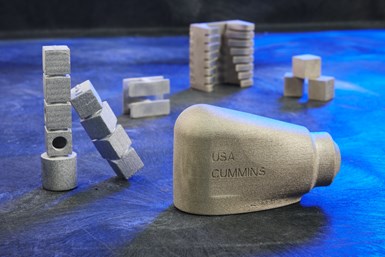Cummins Finalizes First Metal 3D Printed Production Part
Company is using high-precision binder jetting process to create lance tip adapter used in high horsepower engines.

Binder jet printed CES lance tip adapter
Cummins Inc. is finalizing its first production part using binder jetting, a high-precision 3D metal printing technology. The part is a Cummins Emission Solutions (CES) lance tip adapter used in high horsepower engines.
The lance tip adapter is a critical emissions component in Cummins engines as it atomizes and injects diesel exhaust fluid into the engine exhaust stream to reduce the amount of nitrogen oxides (NOx) emitted from Cummins’ engine systems. The part is now moving through Cummins’ production part approval process. The company hopes to have final part approval and start official production later this year.
“We’re on the cusp of being able to leverage a broad range of additive technologies to print the parts we need, using the right technology and at lower costs and increased speeds,” says Tim Millwood, vice president of global manufacturing.
Producing this part through AM provides several additional benefits, including a lighter weight design, improved geometry for fluid and air flow, and the elimination of the added complexity of cross drillings. It also has environmental benefits. Unlike traditional machining, the binder jet printer can take nearly 100% of the leftover powder from the printed part, recirculate it through the system and reuse it in the production of other parts.
In April 2019, Cummins announced its investment in binder jet technology, where a printhead moves across a bed of powdered metal and selectively deposits a liquid binding agent in the shape of the part cross section, bonding these areas together to form a solid part one layer at a time. Depending on the complexity of the part, the technology can print 60 to 100 times faster than other laser-based printing processes, enabling high-volume production with this technology, the company says.
The Cummins AM and Engineering teams are also working on designing and printing several additional concept parts, with the hopes of finalizing more parts yet this year.
Related Content
-
DMG MORI: Build Plate “Pucks” Cut Postprocessing Time by 80%
For spinal implants and other small 3D printed parts made through laser powder bed fusion, separate clampable units resting within the build plate provide for easy transfer to a CNC lathe.
-
How Norsk Titanium Is Scaling Up AM Production — and Employment — in New York State
New opportunities for part production via the company’s forging-like additive process are coming from the aerospace industry as well as a different sector, the semiconductor industry.
-
Additive Manufacturing Is Subtractive, Too: How CNC Machining Integrates With AM (Includes Video)
For Keselowski Advanced Manufacturing, succeeding with laser powder bed fusion as a production process means developing a machine shop that is responsive to, and moves at the pacing of, metal 3D printing.













